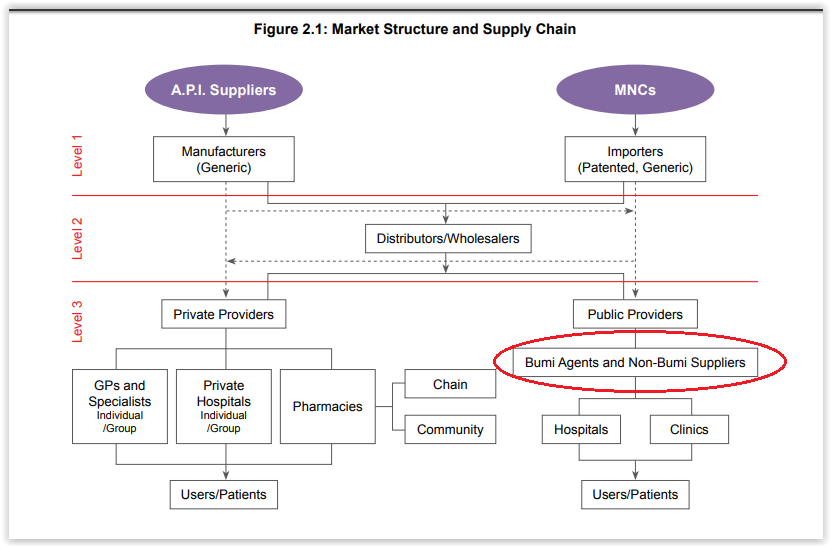The Ministry of Health may possibly introduce a price control mechanism for drugs in the middle of the year.
Health Minister Dzulkefly Ahmad told the Dewan Rakyat last November that the government wanted to set ceiling retail prices for consumers at all dispense channels to make medicines more affordable.
Price regulations are an excessive form of government intervention that should be avoided as much as possible because they may have unintended consequences, such as the shuttering of small clinics or pharmacies who cannot cope with further reductions of their already razor-thin profit margins.
With so many payers in the health care market – Health Ministry (for MOH hospitals), Education Ministry (for university hospitals), Defence Ministry (for army hospitals), private hospitals, chain and community pharmacies, GPs – how is the government going to decide the ceiling price and profit margin?
Will bigger companies like private hospitals be allowed larger margins because they have more staff to take care of, compared to a GP’s clinic? In any case, on principle, it is the market that should decide profit margins, not the State.
At a recent roundtable by the Galen Centre on the rising costs of health care, I was bemused to see doctors, pharmacists, hospital and pharmaceutical representatives all claim that they were not responsible for the increasingly expensive cost of health care as they had narrow profit margins.
Pharmaceutical companies, especially foreign ones, seem the easiest target to blame for expensive drug prices. But a study by the United States Government Accountability Office (GAO) (GAO), an independent watchdog of the US Congress, paints a more complex picture.
The GAO’s report, which looked at data from 2006 to 2015, found that the average profit margins for all drug companies worldwide in 2015 was 17.1 per cent. The average profit margin for the worldwide top 25 biopharmaceutical companies that year was 20.1 per cent, but for the remaining companies, it was only 8.6 per cent.
Comparatively, the average profit margins for the worldwide 25 biggest software companies were 13.4 per cent in 2015 (GAO singled out the software industry because it purportedly has “high R&D investment and low production and distribution costs” like the drug industry).
The average profit margins for the world’s largest 500 companies (excluding pharmaceutical, biotechnology, and software companies) were 6.7 per cent in 2015. The 6.7 per cent figure isn’t that much lower than the 8.6 per cent margin of a drug company that isn’t among the top 25 biggest, so it would be misleading to only focus on the pharmaceutical industry average of 17.1 per cent.
That being said, we still want cheaper drugs, especially when many Malaysians are spending their own money on health care as opposed to using health insurance. Out of the private sector health expenditure (which made up 49 per cent of total health expenditure in 2015), out-of-pocket expenditure comprised a whopping 78 per cent, compared to only 16 per cent by private insurance.
On the public sector side, the government reportedly spent three to four times the international reference prices (benchmark of prices of drugs in other countries) for drugs between 2010 and 2014.
And just because a medicine, like targeted therapy for cancer, is listed on the national formulary, it does not necessarily mean that all patients in public hospitals have access to it as there is limited supply.
So how do we reduce the cost of life-saving medicine in Malaysia without taking the extreme measure of price regulations?
Let’s look at public procurement of drugs first, since it is arguably easier for the government to negotiate better prices due to its large purchasing power compared to much smaller payers in the private sector.
Public health expenditure is not fully concentrated in one party. In 2015, the Health Ministry comprised 84 per cent of public health expenditure, followed by the-then Higher Education Ministry (4 per cent), other federal agencies (8 per cent), and others (4 per cent).
Why isn’t the government combining drug purchasing by the Health, Education, Defence Ministries and other public agencies? That would give the government stronger purchasing power. The government can do this by setting up an independent agency, like the National Institute for Health and Care Excellence (NICE) in the United Kingdom, to negotiate with pharmaceutical companies for all government health care providers as a single entity and decide what treatments should be available in public hospitals.
Another simple method to reduce drug prices for the government is to totally cut Bumiputera tender agents (which act as intermediaries between public hospitals on one hand, and both local non-Bumiputera and foreign pharmaceutical companies on the other) from the public procurement process.
According to the Malaysia Competition Commission’s (MyCC) Market Review on Pharmaceutical Sector under Competition Act 2010, (see Chapter 2), Bumiputera agents charge a fee of between 2 and 3 per cent for just basically passing along papers (tender documents) from supplier to government.
And it is pharmaceutical companies, not tender agents, who are responsible for supply and handling logistics services. “Acting as tender agents, they do not take ownership of the products supplied; pricing is determined by the principals and logistics are provided by other independent distributors”, states MyCC. So tender agents exist just for the sake of it and do not add real value.
Exceptions that provide warehouse and logistics services include Pharmaniaga, the largest Bumiputera tender agent with exclusive concession to supply 700 items in the Approved Product Purchase List (APPL), determined by MOH, to government hospitals, institutions, and clinics. For some reason, Pharmaniaga has received sole concession for a whopping 25 years since the government privatised the medicine procurement system in 1994.

Market Review on Pharmaceutical Sector under Competition Act 2010
Pharmaniaga’s concession is to provide logistics and distribution services for all products procured under the APPL channel (though Pharmaniaga also has its own manufacturing companies). Under the APPL channel, according to MyCC, Pharmaniaga “supplied 38.5 per cent of the total cost of medicines procured for all MOH hospitals, institutions and clinics in 2015”.
First, it is ridiculous that our own (non-Bumiputera) drug companies are prohibited from dealing directly with the government and are treated like foreign corporations. This is utterly discriminatory.
Second, I argue that the Bumiputera preference policy should be eradicated completely in the public procurement of drugs and other medical supplies.
Bumiputera policies may be retained in other industries, but health care must be exempt. We have a moral duty not to allow people to fall sick or die when they are prevented from getting treatment due to exorbitant cost.
The health of over 32 million Malaysians is more important than a few Bumiputera companies.
The government can already save 2 to 3 per cent by removing all Bumiputera tender agents from the public procurement process.
If Bumiputera preference is abolished so that all local and foreign pharmaceutical companies get equal consideration for government contracts, the government may get better or cheaper deals in an open competitive market.
There may not be a need for preference for local products because local and foreign pharmaceutical companies generally operate in different markets – the former manufactures generic medicines while the latter imports patented drugs.
Pharmaceutical companies may also be more motivated to give the government, rather than small tender agents, discounts.
There are lots of ways to reduce drug prices. A price ceiling is not one of them.

Boo Su-Lyn is a libertarian writer who believes in minimal state intervention in the economy and socio-political issues. Read her at boosulyn.com. Share your ideas with her at fb.com/boosulyn, tweet her @boosulyn, follow her lifestyle at IG @boosulyn, and watch her at youtube.com/c/boosulyn.
- This is the personal opinion of the writer or publication and does not necessarily represent the views of CodeBlue.








